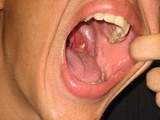
Tonsillolith
Overview
Tonsilloliths, also known as a tonsil stones, are clusters of calcified material that form in the crevices of the tonsils. While they occur most commonly in the palatine tonsils, they may also occur in the lingual tonsils
. Tonsilloliths have been recorded weighing from 300 mg to 42 g. They are composed mostly of calcium
, but may contain other minerals such as phosphorus
and magnesium
, as well as ammonia
and carbonate
.
Protruding tonsilloliths may feel like foreign objects lodged in the tonsil crypt
.
Lingual tonsils
The lingual tonsils are rounded masses of lymphatic tissue that cover the posterior region of the tongue.They are located on the dorsal surface at the base of the tongue. Their lymphatic tissue are dense and nodular, their surface is covered with stratified squamous epithelium which invaginates as...
. Tonsilloliths have been recorded weighing from 300 mg to 42 g. They are composed mostly of calcium
Calcium
Calcium is the chemical element with the symbol Ca and atomic number 20. It has an atomic mass of 40.078 amu. Calcium is a soft gray alkaline earth metal, and is the fifth-most-abundant element by mass in the Earth's crust...
, but may contain other minerals such as phosphorus
Phosphorus
Phosphorus is the chemical element that has the symbol P and atomic number 15. A multivalent nonmetal of the nitrogen group, phosphorus as a mineral is almost always present in its maximally oxidized state, as inorganic phosphate rocks...
and magnesium
Magnesium
Magnesium is a chemical element with the symbol Mg, atomic number 12, and common oxidation number +2. It is an alkaline earth metal and the eighth most abundant element in the Earth's crust and ninth in the known universe as a whole...
, as well as ammonia
Ammonia
Ammonia is a compound of nitrogen and hydrogen with the formula . It is a colourless gas with a characteristic pungent odour. Ammonia contributes significantly to the nutritional needs of terrestrial organisms by serving as a precursor to food and fertilizers. Ammonia, either directly or...
and carbonate
Carbonate
In chemistry, a carbonate is a salt of carbonic acid, characterized by the presence of the carbonate ion, . The name may also mean an ester of carbonic acid, an organic compound containing the carbonate group C2....
.
Protruding tonsilloliths may feel like foreign objects lodged in the tonsil crypt
Tonsillar crypts
Tonsils consist of an extensive system of crypts, which result in a large internal surface. The tonsils contain four lymphoid compartments that influence immune functions, namely the reticular crypt epithelium, the extrafollicular area, the mantle zones of lymphoid follicles, and the follicular...
.
Unanswered Questions

